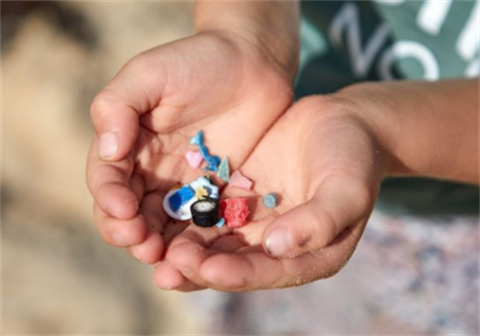Noosa Coastal Cleanup

What?
What are microplastics?
Pieces of plastic from less than 5mm in size, down to microscopic sizes. They are found everywhere in the environment, in ice and snow, soils, airborne dust, and in our waterways and oceans. There is increasing evidence that they are detectable throughout human and animal bodies.
Some microplastics start small (primary microplastics), such as plastic grit in facial cleansers, toothpastes and sunscreen, and as craft and cosmetic glitter. Some microplastics are formed as larger plastic items such as bags, containers, packaging, general use goods, and plastic paints and coatings degrade and abrade into small pieces (secondary microplastics).
Microplastics on the beach
While microplastics are always common on our beaches, recent severe weather has mobilised more plastic than usual in the ocean, and each tide deposits a new load of microplastics and some macroplastic to our beaches. The Noosa community and visitors to our beautiful beaches have seen these swathes of microplastics and want to do something about it.
Why?
Plastic rubbish can kill wildlife like turtles, seals and seabirds by drowning or starving them. Plastic can entangle wildlife, making is so difficult to swim they can no longer catch enough food, or they drown. Plastic can look like food, and when swallowed can block digestive tracts or permanently fill animals’ stomachs so they no can longer eat and starve to death.
How?
Every day: Pick up little pieces of plastic on the beach, pick up any litter you see, reduce your plastic use and make sure all rubbish is recycled or put in the bin.
Cleanup events: Keep an eye on the Coastal Cleanup calendar here, follow the community cleanup groups listed below or follow Noosa Council’s Facebook
Subscribe to Coastal Cleanup: Keep up to date with clean-up opportunities and information by subscribing to Noosa Council’s Coastal Cleanup Wrap-up by clicking on the link below or sending an email to Coastal Cleanup at environment@noosa.qld.gov.au

Photo credit: Plastic Free Noosa
Council Coastal Cleanup events
Noosa’s coastal cleanup program is new and continues to grow. Keep an eye on this space as we add Council Coastal Cleanup events.
Community cleanup champions
Join our community cleanup champions as they work to reduce plastic use and rubbish in our environment, and at their community cleanup and monitoring events.
Here are just a few of the local groups you can join:
Coolum and North Shore Coast Care
Coolum and North Shore Coast Care was formed to protect the coastal environment and its flora and fauna, and to maintain the natural state of this unique part of the world we are lucky to live in.
Website: https://coolumcoastcare.org.au
Facebook: https://www.facebook.com/CoolumandNorthShoreCoastCare/
Phone: 0478 435 377
Email: info@coolumcoastcare.org.au
Noosa Integrated Catchment Assoc Inc
Dedicated to the conservation and sustainable use of the Noosa River catchment. Noosa Integrated Catchment Assoc Inc (NICA) coordinates around 20 public sites each year for Clean-up Australia Day on the first Sunday in March. In the lead up to the event the list of sites will be on our website and advertised in local papers.
Doonella House at 52 Doonella Street, Tewantin
Tel: (07)5449 9650
Email: admin@noosariver.com.au
Website: www.noosariver.com.au
Plastic Free Noosa
Plastic Free Noosa aims to help local businesses, residents and visitors to Noosa easily eliminate single-use plastics from their everyday life.
info@plasticfreenoosa.org
plasticfreenoosa.org
visitnoosa.com.au
Sunshine Coast Surfrider Foundation
Surfrider Foundation Limited is dedicated to the protection of Australia’s ocean, beaches and waves through conservation, activism, research and education.
sunshinecoast@surfrider.org.au
Tangaroa Blue Foundation
Australian Marine Debris Initiative
Tangaroa Blue Foundation coordinates the Australian Marine Debris Initiative (AMDI), an on-ground network of volunteers, communities, organisations and agencies around the country monitoring the levels, impacts and sources of marine debris along their stretch of coastline.
Ph: 0401 228 587
www.tangaroablue.org
https://tangaroablue.org/database/
Ten Little Pieces
Ten Little Pieces empowers communities to take meaningful action against plastic pollution through hands-on clean-ups and dynamic education programs. By inspiring sustainable habits and fostering environmental awareness, the initiative turns small, everyday actions into impactful change
Web: http://www.tenlittlepieces.com
Instagram: http://www.instagram.com/tenlittlepieces
Facebook: http://www.facebook.com/tenlittlepieces
If you would like to add your group, please send an email titled 'Coastal Cleanup' to environment@noosa.qld.gov.au.
Pontoon: The Polystyrene ‘White Spill’ Disaster
This short film explores the impact of the polystyrene pollution that occured along Noosa's eastern beaches during severe weather and flooding in February/March 2022.
18 large polystyrene pontoons washed north from Brisbane during the weather event came ashore on Noosa’s east coast beaches.
The large, waterlogged pontoons, comprised of concrete, polystyrene and plastic, were extremely difficult to remove.
Tonnes of polystyrene spread across beaches, creating the ‘White Spill’ pollution disaster.
Through interviews, media coverage and local footage, the film includes many perspectives to arrive at some key lessons learned.